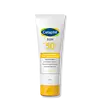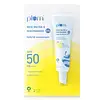What's inside
What's inside
 Key Ingredients
Key Ingredients

 Benefits
Benefits

 Concerns
Concerns

 Ingredients Side-by-side
Ingredients Side-by-side

Water
Skin ConditioningEthylhexyl Salicylate
UV AbsorberMethylene Bis-Benzotriazolyl Tetramethylbutylphenol
UV FilterBis-Ethylhexyloxyphenol Methoxyphenyl Triazine
Skin ConditioningDiethylhexyl Butamido Triazone
UV AbsorberButyl Methoxydibenzoylmethane
UV AbsorberC12-15 Alkyl Benzoate
AntimicrobialDibutyl Adipate
EmollientPentylene Glycol
Skin ConditioningAlcohol
AntimicrobialSorbitol
HumectantDimethicone
EmollientCetyl Phosphate
EmulsifyingCetyl Alcohol
EmollientTriethanolamine
BufferingTocopherol
AntioxidantDecyl Glucoside
CleansingLecithin
EmollientAcrylic Acid/Vp Crosspolymer
Propylene Glycol
HumectantXanthan Gum
EmulsifyingAloe Barbadensis Leaf Juice Powder
Skin ConditioningWater, Ethylhexyl Salicylate, Methylene Bis-Benzotriazolyl Tetramethylbutylphenol, Bis-Ethylhexyloxyphenol Methoxyphenyl Triazine, Diethylhexyl Butamido Triazone, Butyl Methoxydibenzoylmethane, C12-15 Alkyl Benzoate, Dibutyl Adipate, Pentylene Glycol, Alcohol, Sorbitol, Dimethicone, Cetyl Phosphate, Cetyl Alcohol, Triethanolamine, Tocopherol, Decyl Glucoside, Lecithin, Acrylic Acid/Vp Crosspolymer, Propylene Glycol, Xanthan Gum, Aloe Barbadensis Leaf Juice Powder
Water
Skin ConditioningEthylhexyl Methoxycinnamate
UV AbsorberButyl Methoxydibenzoylmethane
UV AbsorberBenzophenone-3
UV AbsorberPhospholipids
Skin ConditioningButylene Glycol
HumectantPropanediol
SolventNiacinamide
SmoothingGlycerin
HumectantTitanium Dioxide
Cosmetic ColorantRice Ferment Filtrate
Skin ConditioningOryza Sativa Extract
AbsorbentAluminum Hydroxide
EmollientBenzyl Alcohol
PerfumingHydroxyacetophenone
AntioxidantStearic Acid
CleansingCaprylyl Glycol
EmollientAmmonium Acryloyldimethyltaurate/Vp Copolymer
Sodium Polyacryloyldimethyl Taurate
Emulsion StabilisingSodium Benzoate
MaskingPotassium Sorbate
PreservativeSodium Gluconate
Skin ConditioningPanthenol
Skin ConditioningWater, Ethylhexyl Methoxycinnamate, Butyl Methoxydibenzoylmethane, Benzophenone-3, Phospholipids, Butylene Glycol, Propanediol, Niacinamide, Glycerin, Titanium Dioxide, Rice Ferment Filtrate, Oryza Sativa Extract, Aluminum Hydroxide, Benzyl Alcohol, Hydroxyacetophenone, Stearic Acid, Caprylyl Glycol, Ammonium Acryloyldimethyltaurate/Vp Copolymer, Sodium Polyacryloyldimethyl Taurate, Sodium Benzoate, Potassium Sorbate, Sodium Gluconate, Panthenol
Ingredients Explained
These ingredients are found in both products.
Ingredients higher up in an ingredient list are typically present in a larger amount.
Also known as Avobenzone, this ingredient is a chemical sunscreen filter that provides protection in the UV-A range.
Avobenzone is globally approved and is the most commonly used UV-A filter in the world.
Studies have found that avobenzone becomes ineffective when exposed to UV light (it is not photostable; meaning that it breaks down in sunlight). Because of this, formulations that include avobenzone will usually contain stabilizers such as octocrylene.
However, some modern formulations (looking at you, EU!) are able to stabilize avobenzone by coating the molecules.
Avobenzone does not protect against the UV-B range, so it's important to check that the sunscreen you're using contains other UV filters that do!
The highest concentration of avobenzone permitted is 3% in the US, and 5% in the EU.
Learn more about Butyl MethoxydibenzoylmethaneWater. It's the most common cosmetic ingredient of all. You'll usually see it at the top of ingredient lists, meaning that it makes up the largest part of the product.
So why is it so popular? Water most often acts as a solvent - this means that it helps dissolve other ingredients into the formulation.
You'll also recognize water as that liquid we all need to stay alive. If you see this, drink a glass of water. Stay hydrated!
Learn more about Water